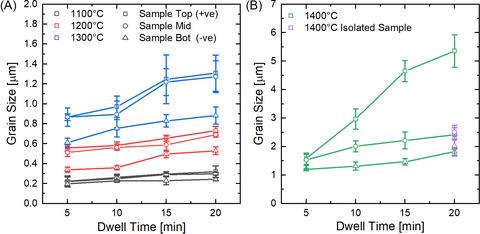当前位置:
X-MOL 学术
›
J. Am. Ceram. Soc.
›
论文详情
Our official English website, www.x-mol.net, welcomes your
feedback! (Note: you will need to create a separate account there.)
Polarity‐induced grain growth of gadolinium‐doped ceria under field‐assisted sintering technology/spark plasma sintering (FAST/SPS) conditions
Journal of the American Ceramic Society ( IF 3.5 ) Pub Date : 2020-12-06 , DOI: 10.1111/jace.17614 Sree Koundinya Sistla 1 , Tarini Prasad Mishra 2 , Yuanbin Deng 1 , Anke Kaletsch 1 , Martin Bram 2 , Christoph Broeckmann 1
Journal of the American Ceramic Society ( IF 3.5 ) Pub Date : 2020-12-06 , DOI: 10.1111/jace.17614 Sree Koundinya Sistla 1 , Tarini Prasad Mishra 2 , Yuanbin Deng 1 , Anke Kaletsch 1 , Martin Bram 2 , Christoph Broeckmann 1
Affiliation

|
This study aims to understand the effect of the electrical field on microstructure evolution during field‐assisted sintering or spark plasma sintering (FAST/SPS) of 10 mol% gadolinium‐doped ceria (GDC) with experimental and numerical methods. The novelty of this study has been the observation of enhanced grain growth in the region closer to the anode, even under FAST/SPS conditions with electrical fields less than 5 V/cm. The grain growth kinetics, including determination of activation energy and grain‐boundary mobility, were analyzed along the cross section of the samples for different temperatures and dwell periods. With an increase in distance from the anode, reduction in the activation energy for grain growth and grain‐boundary mobility was observed. These observations attributed to the attraction of oxygen ions to the anode region under an electrical field with an increase in defects along the grain boundaries. Thereby an increase in the grain‐boundary mobility and larger grains in that region were observed. A homogenous microstructure was observed in a case where the current did not flow through the sample. Furthermore, a numerical strategy has also been developed to simulate this behavior in addition to heat generation, heat transfer, and densification using Finite Element Methods (FEM) simulations. The simulation results provided an insight into the presence of a potential difference across the cross section of the samples. The simulation results were also in good agreement with the experimental observations.
中文翻译:

磁场辅助烧结技术/火花等离子体烧结(FAST / SPS)条件下掺杂二氧化铈的极性诱导晶粒生长
本研究旨在通过实验和数值方法来了解电场对10 mol%掺ped二氧化铈(GDC)的现场辅助烧结或火花等离子体烧结(FAST / SPS)期间微观组织演变的影响。这项研究的新颖之处在于,即使在电场小于5 V / cm的FAST / SPS条件下,也可以观察到更靠近阳极的区域中晶粒的生长得到增强。在不同温度和停留时间下,沿着样品的横截面分析了晶粒生长动力学,包括确定活化能和晶界迁移率。随着距阳极距离的增加,观察到晶粒生长和晶界迁移率的活化能降低。这些观察结果归因于电场下氧离子吸引到阳极区域,并且沿着晶界的缺陷增加。因此,观察到该区域的晶界迁移率增加并且晶粒更大。在电流没有流过样品的情况下,观察到均匀的微观结构。此外,还开发了一种数值策略来模拟这种行为,除了使用有限元方法(FEM)模拟产生热量,传热和致密化以外。模拟结果提供了对样品横截面中存在电势差的见解。仿真结果也与实验结果吻合良好。因此,观察到该区域的晶界迁移率增加并且晶粒更大。在电流没有流过样品的情况下,观察到均匀的微观结构。此外,还开发了一种数值策略来模拟这种行为,除了使用有限元方法(FEM)模拟产生热量,传热和致密化以外。模拟结果提供了对样品横截面中存在电势差的见解。仿真结果也与实验结果吻合良好。因此,观察到该区域的晶界迁移率增加并且晶粒更大。在电流没有流过样品的情况下,观察到均匀的微观结构。此外,还开发了一种数值策略来模拟这种行为,除了使用有限元方法(FEM)模拟产生热量,传热和致密化以外。模拟结果提供了对样品横截面中存在电势差的见解。仿真结果也与实验结果吻合良好。还开发了一种数值策略来模拟这种行为,此外还使用有限元方法(FEM)模拟来模拟热量的产生,传热和致密化。模拟结果提供了对样品横截面中存在电势差的见解。仿真结果也与实验结果吻合良好。还开发了一种数值策略来模拟这种行为,此外还使用有限元方法(FEM)模拟来模拟热量的产生,传热和致密化。仿真结果提供了对样品横截面中存在电势差的见解。仿真结果也与实验结果吻合良好。
更新日期:2020-12-06
中文翻译:

磁场辅助烧结技术/火花等离子体烧结(FAST / SPS)条件下掺杂二氧化铈的极性诱导晶粒生长
本研究旨在通过实验和数值方法来了解电场对10 mol%掺ped二氧化铈(GDC)的现场辅助烧结或火花等离子体烧结(FAST / SPS)期间微观组织演变的影响。这项研究的新颖之处在于,即使在电场小于5 V / cm的FAST / SPS条件下,也可以观察到更靠近阳极的区域中晶粒的生长得到增强。在不同温度和停留时间下,沿着样品的横截面分析了晶粒生长动力学,包括确定活化能和晶界迁移率。随着距阳极距离的增加,观察到晶粒生长和晶界迁移率的活化能降低。这些观察结果归因于电场下氧离子吸引到阳极区域,并且沿着晶界的缺陷增加。因此,观察到该区域的晶界迁移率增加并且晶粒更大。在电流没有流过样品的情况下,观察到均匀的微观结构。此外,还开发了一种数值策略来模拟这种行为,除了使用有限元方法(FEM)模拟产生热量,传热和致密化以外。模拟结果提供了对样品横截面中存在电势差的见解。仿真结果也与实验结果吻合良好。因此,观察到该区域的晶界迁移率增加并且晶粒更大。在电流没有流过样品的情况下,观察到均匀的微观结构。此外,还开发了一种数值策略来模拟这种行为,除了使用有限元方法(FEM)模拟产生热量,传热和致密化以外。模拟结果提供了对样品横截面中存在电势差的见解。仿真结果也与实验结果吻合良好。因此,观察到该区域的晶界迁移率增加并且晶粒更大。在电流没有流过样品的情况下,观察到均匀的微观结构。此外,还开发了一种数值策略来模拟这种行为,除了使用有限元方法(FEM)模拟产生热量,传热和致密化以外。模拟结果提供了对样品横截面中存在电势差的见解。仿真结果也与实验结果吻合良好。还开发了一种数值策略来模拟这种行为,此外还使用有限元方法(FEM)模拟来模拟热量的产生,传热和致密化。模拟结果提供了对样品横截面中存在电势差的见解。仿真结果也与实验结果吻合良好。还开发了一种数值策略来模拟这种行为,此外还使用有限元方法(FEM)模拟来模拟热量的产生,传热和致密化。仿真结果提供了对样品横截面中存在电势差的见解。仿真结果也与实验结果吻合良好。









































 京公网安备 11010802027423号
京公网安备 11010802027423号